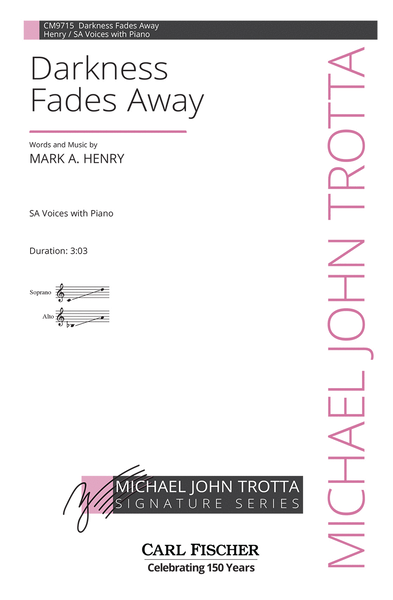Darkness Fades Away
-
Ships in 1 to 2 weeks
Details
Description
SKU: CF.CM9715
Composed by Mark A Henry. Mjts. 8 pages. Duration 3 minutes, 3 seconds. Carl Fischer Music #CM9715. Published by Carl Fischer Music (CF.CM9715).ISBN 9781491160947. UPC: 680160919543. Key: F major. Original.
Darkness Fades Away is written as an accessible song for young voices that speaks to our hopes for a kinder and more empathetic world. The melody utilizes a subtle meter change from 2 /4 to 3/4 in order to emphasize the second beat and allow it space to grow into the next note. When the optional counter-melody is introduced, the rhythm relies on an off-beat pattern, but be sure not to accent those notes. Both melody and counter-melody are meant to flow gently with a little movement throughout. Note the repeated use of a 7th (low sol to fa) to introduce the main motif. The ending section grows to its climax (m. 80-82) with optional notes for higher voices that feel comfortable in that range. After the voices echo and repeat the main theme, the rallentando and subsequent caesura (m. 104-106) allow for some freedom in direction until the piano reinforces the original tempo before itself fading away.
Darkness Fades Away is written as an accessible song for young voices that speaks to our hopes for a kinder and more empathetic world. The melody utilizes a subtle meter change from 2 /4 to 3/4 in order to emphasize the second beat and allow it space to grow into the next note. When the optional counter-melody is introduced, the rhythm relies on an off-beat pattern, but be sure not to accent those notes. Both melody and counter-melody are meant to flow gently with a little movement throughout. Note the repeated use of a 7th (low sol to fa) to introduce the main motif.The ending section grows to its climax (m. 80-82) with optional notes for higher voices that feel comfortable in that range. After the voices echo and repeat the main theme, the rallentando and subsequent caesura (m. 104-106) allow for some freedom in direction until the piano reinforces the original tempo before itself fading away.

 Share
Share